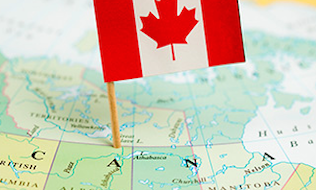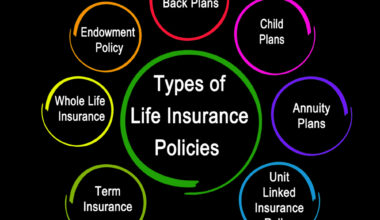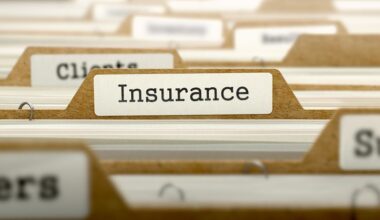There are many good reasons to consider buying a life insurance policy, such as a recent marriage, a new baby, or taking on a large debt (like a house) that loved ones would have trouble paying off if something happened to you. Or perhaps you have witnessed first-hand the impact that death has on surviving family members’ finances.
If you’re in the market for life insurance or have recently bought a policy, make sure you don’t put your family’s finances in jeopardy by making these mistakes.
Getting Life Insurance
Life insurance is a financial contract that pays out a death benefit to one’s heirs or other beneficiaries in the event of their death. The purpose of this death benefit is to replace any current and future income lost due to that death, to cover any outstanding debts and obligations of that person, and to leave some additional money as an inheritance or legacy.
Life insurance today exists in a competitive marketplace, with many companies offering several types of policies and products. Term life insurance is the most basic form of coverage, providing a level of a death benefit for a set period of years (e.g., 20 years). Once the term runs out, you will need to re-apply for new coverage if you so choose. Permanent life insurance can last your entire life, and often comes with a cash accumulation component. The premiums on these types of policies tend to be more expensive compared to term, but also come with additional benefits and value.
Regardless of which type of insurance you decide to go with, the application process will be similar. You will need to provide your basic information, and financial picture, and complete a health survey. In addition to the survey, you will often have to undergo a paramedical exam, during which a trained healthcare professional will examine you and may request a sample of blood and urine for analysis. This is because life insurance rates are linked to the statistical probability that you will die and the insurer will have to pay out a claim.
As a result, insurance premiums are often the lowest for younger people (who are often healthier and have longer lives) and for healthier people. Those with health conditions or who have riskier lifestyles (e.g., smokers) can expect to pay more.
Once approved, you will have to pay regular policy premiums (which can be set anywhere from monthly to annually). So long as you continue to pay your premiums, the policy will remain in force; otherwise, it may lapse and your coverage will be forfeited.
1: Waiting to Buy Insurance
When purchasing life insurance, it’s important to consider the amount of coverage you need as well as the cost. Life insurance premiums are based on several factors, including your age and overall health.
Buying a life insurance policy sooner, rather than later, can work in your favor if you’re hoping to secure a policy at the lowest possible cost. Life insurance rates generally increase as people age or their health deteriorates. And, in some cases, illnesses or health problems may make you ineligible for coverage. The longer you put off the buying decision the more the insurance will probably cost—if you can buy it at all.
2: Buying the Cheapest Policy
While it is essential to shop for a policy that’s affordably priced, it’s important to consider what you’re getting in return, in terms of coverage. Life insurance policies can be a bit complicated, so it’s a good idea to learn about their features and benefits.
For example, term life insurance tends to be cheaper than permanent life insurance. But there’s a caveat: term life insurance only covers you for a set period while permanent life insurance can cover you until death, as long as your premiums are paid.
If you believe you’ll only need life insurance for a set period, say 20 or 30 years, then a term life policy can be an affordable option. On the other hand, if you’re interested in lifetime coverage or you want to own a life insurance policy that builds cash value as an investment vehicle, then it could be worth it to pay more in premiums for permanent coverage. Try comparing the quotes of different life insurance policies to determine what you might be giving up in exchange for a cheaper deal.
3: Allowing Premiums to Lapse
When purchasing life insurance, you’re expected to pay a premium in return for coverage. Again, these premiums can be based on your insurance risk class, which correlates to your age, health, and other factors. If you’re considering buying a universal life policy with secondary guarantees—low-premium guaranteed death benefits for life or for a specified period—a late payment can impact the policy benefits.
Universal life is a special type of permanent policy that has been marketed as having long-term guaranteed protection at the lowest possible rate—it is very different from term insurance. While many of these types of policies have a cash surrender value, universal life with secondary guarantees focuses on maximizing the amount of insurance available per dollar of premium.
Some of these policies can be sensitive to the timing of premium payments. For example, if you happen to miss a monthly payment—or are more than a month late sending in your check—your guaranteed policy may no longer be guaranteed. A policy purchased with guaranteed coverage to age 100 might only protect age 92 if one payment is late or missed, which could be problematic if you live longer.
4: Forgetting Insurance Is an Investment
A variable life insurance policy is a permanent type of policy that provides life insurance protection with cash value. Part of the premium goes toward life insurance, and part goes into a cash-value account that is invested in various investments similar to the mutual funds that you choose. Like mutual funds, the value of these accounts fluctuates and is based on the performance of the underlying investments. People often look to these policy values in the future as a source of funds to supplement their retirement income.
You must fund a variable life policy sufficiently to maximize its cash value growth. This means continuing to make adequate premium payments, especially during times of poor investment returns. Paying less than originally planned can have a big impact on the cash value available to you in the future. It’s also important to monitor your policy’s performance and periodically rebalance your accounts to your desired allocation, just as you would with any investment account. This will help ensure you’re not taking on more risk than you had planned when you set up your account.
5: Borrowing From Your Policy
Permanent life insurance policies that accumulate cash value could be a source of funds when you need to borrow money. The cash value of a permanent policy can generally be used for any reason you see fit, including tax-free withdrawals and loans, if done properly.
This is a great benefit, but it must be carefully managed. If you take too much money out of your policy and your policy lapses or runs out of money, all the gains you’ve taken out will become taxable. Not to mention, you may significantly reduce the death benefit that’s available to your beneficiaries when you pass away.
If you have taken too much money out and your policy is about to lapse, you may be able to maintain the policy by making additional premium payments, assuming you can afford them. When accessing your life insurance policy’s cash value, be sure to monitor it closely and consult your tax advisor to avoid any unwanted tax liability.
6: Choosing an insurance agent or broker
Before choosing an insurance agent or broker, you may want to ask your friends and family if they can recommend someone they have dealt with.
Ask the agent or broker:
- to provide references from other clients
- about their training and qualifications
- if they have passed the Life License Qualification Program (LLQP) if you’re buying life insurance
- if they belong to a professional association, such as Advocis, the Financial Advisors Association of Canada, or the Insurance Brokers Association of Canada
- how long they have been in business
- what services they will provide after selling you the policy
7: Decide how much insurance coverage you need
8: Decide if you need additional coverage
You may be able to buy extra insurance, known as a rider or endorsement, to pay for risks not covered in your basic policy.
Read your policy carefully and make sure you understand what is and isn’t covered.
9: Decide if you need additional coverage
You may be able to buy extra insurance, known as a rider or endorsement, to pay for risks not covered in your basic policy.
Read your policy carefully and make sure you understand what is and isn’t covered. Very important.






